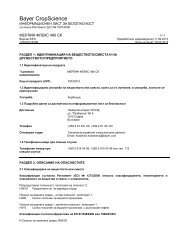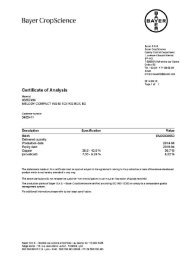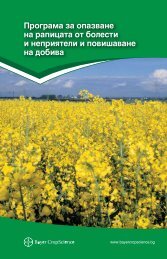Potatoes⦠- Bayer CropScience
Potatoes⦠- Bayer CropScience
Potatoes⦠- Bayer CropScience
You also want an ePaper? Increase the reach of your titles
YUMPU automatically turns print PDFs into web optimized ePapers that Google loves.
“Phytophthora<br />
infestans will<br />
continue to adapt<br />
more rapidly in the<br />
coming years. We<br />
must therefore<br />
outsmart the<br />
pathogen and<br />
attack it in all<br />
possible ways.”<br />
Huub Schepers<br />
mating types are endemic throughout<br />
Europe.<br />
Oospores (which develop via sexual<br />
reproduction) are now found in virtually<br />
all Western and Northern European countries.<br />
In the Netherlands, 60 to 70 % of all<br />
potato-growing areas have mixed populations<br />
of A1 and A2, according to long-term<br />
surveys by the PPO Research Centre. Early<br />
infection caused by oospores occurs mainly<br />
in lighter soils and areas with very short<br />
rotations. This applies particularly to the<br />
North-East of the Netherlands, where<br />
starch potato cultivation is concentrated.<br />
In the period 1999 – 2005, about 32 percent<br />
of all early infections in that region<br />
appeared to be caused by oospores.<br />
Oospores are a considerable<br />
threat<br />
Sexual reproduction via oospores is a serious<br />
threat for potato cultivation, because it<br />
provides for greater variation in the<br />
pathogen population. Laboratory tests and<br />
field studies have shown that the sexuallyreproducing<br />
populations can be considerably<br />
more aggressive than their asexual<br />
predecessors. Research has shown that<br />
the new, mixed populations adapt more<br />
rapidly to temperatures that are normally<br />
unfavourable for Phytophthora; the<br />
pathogen used to be inviable at temperatures<br />
below 10°C and above 25°C, but<br />
this is not the case for the new variants.<br />
Newly-collected isolates are also often<br />
able to survive better on the tuber, as they<br />
tend to damage the tuber less severely: the<br />
tuber rots less rapidly, and is consequently<br />
less easy to sort out on the basis of external<br />
symptoms.<br />
The new population also has a considerably<br />
shorter latent period, meaning that<br />
the life-cycle of Phytophthora infestans<br />
can be completed more rapidly than<br />
before. This, in turn, allows the fungus to<br />
adapt more rapidly through sexual reproduction.<br />
Under favourable conditions, two<br />
generations a week are now possible, compared<br />
with one generation before. It is thus<br />
important to have short intervals in the<br />
spraying programme in areas where<br />
oospores are being formed.<br />
Further threats presented by the new,<br />
mixed populations include the fact that<br />
they often have high spore production<br />
rates, and can break through varietal genetic<br />
resistance more easily. In addition, they<br />
have a broader range of host plants compared<br />
with the ‘old’ Phytophthora: for<br />
example, it is known that the new mixed<br />
populations can also infect green night-<br />
Phytophthora infestans – symptoms<br />
If “Phytophthora-weather“ prevails,<br />
potato tubers can be infected as soon<br />
as they are formed in the middle of<br />
the season.<br />
Above-ground parts of the plant must be<br />
adequately protected right from the start,<br />
in order to prevent inoculum from being<br />
washed down into the soil.<br />
Severe infection of foliage leads to<br />
significant yield losses.<br />
1/08 COURIER 19















